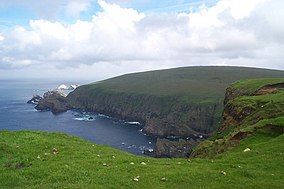| Hermaness National Nature Reserve | |
|---|---|
IUCN category IV (habitat/species management area)[1] | |
 View north from Toolie | |
| Location | Shetland, Scotland |
| Coordinates | 60°50′14″N 0°53′0″W / 60.83722°N 0.88333°W |
| Area | 964.4 ha (2,383 acres)[2] |
| Designation | NatureScot |
| Established | 1955[1] |
| Hermaness National Nature Reserve | |
Hermaness is the northernmost headland of Unst, the most northerly inhabited island of Shetland, Scotland. It consists of huge sea cliffs and moorland, making it an ideal habitat for a variety of birds. Hermaness was designated a national nature reserve (NNR) in 1955. The NNR extends over 965 hectares, including the whole of the Hermaness peninsula and the outlying Muckle Flugga and Out Stack.[2] The reserve has a path and boardwalk that extends out onto the moorland.[3] The reserve is managed by NatureScot, though it remains in private ownership, with most being owned by the Buness Estate, although the stacks and skerries around Muckle Flugga are owned by the Northern Lighthouse Board.[4]
Hermaness is renowned for its internationally important seabird colonies, including the world's third largest great skua colony, fulmars, gannets, shags, puffins and guillemots.[5] The blanket bog further inland also provides a good habitat for breeding waders, such as golden plover, dunlin and snipe.[3]
Hermaness is said to have once been home to a giant named Herman who fought with another giant, named Saxa, over a mermaid. During the fight the two giants threw rocks at each other, and the legend claims that this is the origin of the rocks and stacks that surround the headland.[6]
- ^ a b Cite error: The named reference
planetwas invoked but never defined (see the help page). - ^ a b "Hermaness NNR". NatureScot. Retrieved 16 September 2020.
- ^ a b The Story of Hermaness National Nature Reserve. p. 5.
- ^ The Story of Hermaness National Nature Reserve. p. 24.
- ^ "Hermaness National Nature Reserve". NatureScot. Retrieved 16 September 2020.
- ^ "Visit Hermaness National Nature Reserve" (PDF). Scottish Natural Heritage. 2019. Archived from the original (PDF) on 27 June 2022. Retrieved 16 September 2020.
